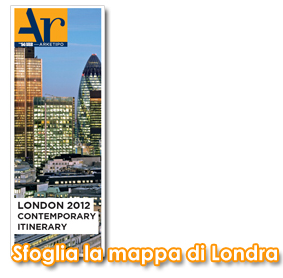Due travi reticolari parallele e dalla forma sinuosa, unite da traversi di acciaio e rivestite con lastre di alluminio aggraffate, formano la pensilina della nuova stazione e avvolgono il volume terminale destinato ai servizi e alle funzioni di supporto. Situata nella cittadina di Slough, borough del Berkshire, in Inghilterra, la nuova stazione degli autobus è il fulcro di un più ampio masterplan, lo "Hearth of Slough", piano da 400 milioni di sterline avente l'obiettivo di una rigenerazione urbana del centro della cittadina, rimpiazzando una serie di edifici terziari dismessi, la vecchia stazione dei bus e un sistema di rotatorie stradali con nuove funzioni pubbliche e commerciali e percorsi pedonali, al fine di creare un ambiente urbano di alta qualità e vivibilità. Il nuovo edificio è localizzato sul lato nord del lotto, lungo Brunel Way, e da qui si sviluppa in direzione nord-sud con una lunga tettoia protettiva: esso va a sostituire la vecchia stazione degli autobus, ormai obsoleta, un edificio per uffici abbandonato e un parcheggio multipiano che creavano una barriera urbana tra la stazione ferroviaria e il centro della città. Progettisti sono i londinesi di bblur architecture, vincitori del concorso di progettazione a inviti, che avvolgono con due strutture tubolari cave il volume a due piani contenente le funzioni richieste dalla committenza e, srotolandole, coprono il percorso pedonale dalla stazione al centro della città; si crea così un oggetto "urbano" elegante, fortemente caratterizzato e caratterizzante l'intorno e "fruibile" visivamente da ogni angolazione, dai passeggeri al livello banchine come dai lavoratori dai piani uffici. Prendendo ispirazione dai lavori sulla lunghezza d'onda della luce dell'astronomo reale Sir William Herschel, nativo di Slough, il volume dell'edificio è, infatti, realizzato con onde di diverso andamento e concepito in modo da rispondere alle esigenze di differenti livelli di protezione contro le intemperie richiesti dai passeggeri e dalle vetture. La nuova stazione risponde, egregiamente, a una serie di istanze della comunità: un punto di interscambio che fornisca un luogo sicuro, efficiente e gradevole alle funzioni del trasporto pubblico; un nuovo asse viario che colleghi la stazione ferroviaria principale, di epoca vittoriana, al centro della città, aumentando la permeabilità pedonale e la caratterizzazione degli spazi pubblici; edificio simbolo, grazie alla sua forma scultorea, quasi una porta per i treni di passaggio sulla vicina linea ferroviaria e diretti alla stazione di London Paddington. Una volta terminato il masterplan, la seconda fase di realizzazione della stazione estenderà la tettoia, ora lunga 70 m, fino a 130 m, proseguendo il suo andamento sinuoso. Le funzioni che trovano posto nel volume dell'edificio, per un totale di 660 mq, sono: la biglietteria, la sala d'aspetto, un'edicola, vari uffici amministrativi, oltre a dieci stalli per i bus al piano terra; altri uffici, una sala riunioni e la mensa del personale al piano primo; le installazioni impiantistiche al secondo. Altro aspetto fondamentale che contribuisce al risultato finale è la scelta materica: l'uso di un rivestimento di alluminio a lastre aggraffate crea una superficie metallica leggermente texturizzata che cambia costantemente aspetto con il variare delle condizioni di illuminazione. La struttura portante è composta da profili di acciaio realizzati in officina, trasportati in loco, preassemblati a tronconi a piè d'opera e successivamente posizionati in quota. Oltre alla forte iconicità, la nuova stazione bus di Slough si contraddistingue anche per la sua sostenibilità ambientale: ha, infatti, ottenuto la classificazione Very Good (la seconda più alta) secondo lo standard BREEAM, la metodologia di valutazione ambientale del Building Research Establishment (BRE). Il primo passo per ottenere questo risultato è stata l'ottimizzazione dell'involucro, con un elevato isolamento e con le aperture vetrate posizionate in maniera opportuna, al fine di evitare carichi termici solari durante la stagione estiva (pur essendo in Inghilterra). Inoltre, l'impianto di climatizzazione è basato su di una pompa di calore con sonde geotermiche, il recupero dell'acqua piovana per il riutilizzo nei wc, il sistema di illuminazione con apparecchi a basso consumo. Il rivestimento a lastre di alluminio è inoltre realizzato al 97% con materiale riciclato e gli stessi supporti sottostanti sono di plastica riciclata.
Two reticular parallel beams with a winding curve, connected by steel braces and clad with seamless aluminium sheets, create the canopy of the new bus station and wrap the volume of the terminal used for the supporting services. The new bus station in Slough, Berkshire England, is the core of a more ambitious masterplan called "the heart of Slough", which is a £ 400 M plan with the objective of regenerating an area of the city centre replacing a series of disused commercial buildings as well as the old bus station and a system of roundabouts with new public and commercial premises and pedestrian routes in order to create a high quality urban environment. The new building is located on the north side of the site along Brunel Way, and from here it develops along a north-south direction with a long protective canopy: it replaces the now obsolete old bus station together with an empty office building and a multi-storey car park which were creating an urban staziobarrier between the railway station and the city centre. The designers are the London practice bblur architecture who won the design competition and wrap with two hollow tubular structures the two-storey volume which contains the functions required by the client and "unwrap" them while covering the pedestrian route from the station to the city centre; they therefore create an elegant urban object, strongly characterised and characterising the surroundings and that can be seen from every angle both by the passengers waiting on the platforms and the occupiers in the office buildings. Taking inspiration from the work on light waves by the royal astronomer Sir William Herschel, who was born in Slough, the volume of the building is infact created with waves of different length and conceived in order to provide different levels of protection from the weather both for passengers and cars. The new station responds brilliantly to a series of issues for the community related to an interchange which can be a safe, efficient and pleasant place for public transport; a new route that connects the main railway station (built in the Victorian era) to the city centre increasing the pedestrian permeability and the characterisation of the public spaces; it is a symbolic building, thanks to its sculptural form almost like a door for the trains in transit on the near railway line and direct to London Paddington Station. Once the masterplan will be completed the second phase of the station works will extend the canopy from 70 m to 130 m extending its winding pattern. The functions located in the 660 mq volume include: ticket office, waiting room, a newsstand, several administrative offices, ten bus stands on the ground floor, other offices, a meeting room and the staff canteen on the fi rst floor; the services are located on the second floor. Another fundamental aspect which contributes to the final result is the choice of materials: the use of an aluminium cladding with seamless sheets creates a slightly textured metallic surface which changes aspect constantly with the different lighting conditions. The main structure is composed of steel profi le manufactured in factory, transported on site, pre-installed in sections on the ground and then lifted into position. In addition to being an icon the new Slough bus station can also be distinguished for its environmental sustainability: it has infact reached the very good BREEAM classifi cation which is the second highest. The first step to achieve this rating was to optimise the envelop with a high insulation and with the glazed openings positioned in order to avoid high thermal loads during the summer season (albeit being in the UK). The air conditioning system is supplied by a heat pump working with geothermal probes, rainwater is collected to be used in toilets and the lighting system uses low energy devices. The aluminium plates cladding is also for the 97% composed of recycled material and the related supports are made of recycled plastic.
scheda progetto
destinazione d'uso/use: stazione degli autobus/bus station
tipologia/type: nuova costruzione/new building
progetto architettonico/architectural design: bblur architecture - Matthew Bedward, Daniel Bérubé
committente/client: Slough Borough Council
progetto strutture/structure engineer: Buro Happold (e impianti meccanici ed elettrici/and mechanicals and electric services)
periodo di costruzione/construction period: 2009-2011
costo/cost: 8,7 milioni euro/7 million pounds






















